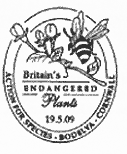|
|
|
|||||||||
|
||||||||||
 |
1st class:
Palm House, Kew Gardens & Millennium Seed Bank, Wakehurst
Place. 90p: Pagoda & Sackler Corssing, Kew Gardens. Stamps are 90p for new postage rates, not 81p as shown. |
The third in Royal Mail's new nature series, 'Action for Species' depicts endangered plants. The accompanying miniature sheet marks the 250th anniversary of the Royal Botanical Gardens at Kew, a World Heritage Site.
Often overlooked, plants are at the base of the food chain and without them no other life forms could exist. However agricultural practices, urbanisation, and pollution have taken their toll, and now almost two in every five wild plants in the UK are of conservation concern. Despite their threatened status, the ten plants selected for inclusion in this stamp series represent a degree of recent conservation success.
The Plants stamp issue celebrates the vital part flora plays in our planet’s bio-diversity and is the third in Royal Mail’s Action for Species series, which looks at the UK’s endangered flora and fauna. The first in the series, Birds, was issued in September 2007, the second, Insects, was issued in April 2008.
To celebrate the 250th anniversary of the Royal Botanic Gardens at Kew a Miniature Sheet of four stamps will be issued on the same date. Kew has a lead role in conserving biodiversity through its scientific and conservation work.
|
|
|
|||||||||
|
||||||||||
 |
1st class:
Palm House, Kew Gardens & Millennium Seed Bank, Wakehurst
Place. 90p: Pagoda & Sackler Corssing, Kew Gardens. Stamps are 90p for new postage rates, not 81p as shown. |
Round-Headed Leek (Allium sphaerocephalon) was first discovered in 1847, in the Avon Gorgenear Bristol. It has since been introduced in a very few, scattered locations.
Floating Water-Plantain (Luronium natans) spread eastwards from its core natural habitats in the lakes of Snowdonia and mid Wales in the 19th century, taking advantage of the canal network. In recent decades, however, pollution and recreational boating have led to its disappearance from many lowland waterways.
Lady's Slipper Orchid (Cypripedium calceolus) has the misfortune to qualify as one of Britain’s rarest plant, having been reduced in the wild to a single specimen in West Yorkshire. Over-grazing, and centuries of over-collecting by gardeners and botanists are to blame for its virtual extinction in Britain.
Dwarf Milkwort (Polygala amarella), long known from the chalk grasslands of the North Downs in Kent and the limestone grasslands of Yorkshire, has declined in recent years, particularly in Kent.
Marsh Saxifrage (Saxifraga hirculus), a rare wild flower of wet moorland and mountain bogs, is now reduced to a few localities, chiefly in the northern Pennines and north-east Scotland, with recent losses attributed to land drainage, over-grazing or afforestation.
Downy woundwort (Stachys germanica) may once have been more widespread, but declined markedly in the 19th century, and is now confined to a small area of Oxfordshire, where it grows mostly along the verges of ancient green lanes and wood borders overlying oolitic limestone.
Upright Spurge (Euphorbia serrulata) is found mostly in a few woodlands in Gloucestershire and Monmouthshire. Cessation of tree cutting and coppicing, which traditionally created well-lit clearings, is probably to blame for its decline.
Plymouth Pear (Pyrus cordata) is a British wild pear that was discovered in 1865 in hedge-banks outside the city of Plymouth. Today, only a few hundred trees exist, in just seven locations.
Sea Knotgrass (Polygonum maritimum) grows just above the high-tide level in a few places along the southern coast of England and Ireland. A Mediterranean species on the edge of its range in southern Britain, it is vulnerable to exceptional tides.
Deptford Pink (Dianthus armeria) was once widespread, but over the past 60 years it has suffered one of the most rapid declines of any species in the British flora, as the dry pastures, field borders and hedgerows it needs have steadily disappeared. It is now restricted to about two dozen sites in England and Wales.
Miniature
sheet:
1st
Class – Palm
House Built 1844-48 by
Richard Turner to Decimus Burton's designs, the Palm House is Kew's
most recognisable building, having gained iconic status as the world's
most important surviving Victorian glass and iron structure. The site
was deliberately chosen to make this great building the focal point of
Nesfield's great vistas- and Burton's Broad Walk.
Technical
details: The 35mm square
stamps
are designed by Studio Dempsey
using photography from the Royal Botanic Gardens Kew and the Natural
History
Museum. In sheets of 30/60 they are printed in lithography, with a
phosphor background screen, by Cartor
Security Printing, perf 14˝. The miniature sheet
was designed by Kate Stephens, using photography of Pagoda in Kew
Gardens © Barry Lewis/Corbis; The Palm House at Kew Gardens in
Winter © Richard Bryant/Arcaid/Corbis; Millennium Seed Bank,
Wakehurst Place © Robert Bird/Alamy; Sackler Crossing, Kew
Gardens © 2009 The Board of Trustees of the Royal Botanic
Gardens, Kew; palm leaf border image © Anna Feruglio Dal Dan.
The 115 x 89mm sheet contains stamps 37x35mm and is printed
in litho by Cartor SP, perforated 14 x 14˝.
The stamp and postmark images
are Copyright 2009 by Royal Mail.
Special
Postmarks
Postmarks available for the day of issue are shown here
these may not be to scale. These
postmarks cannot be obtained after 19 May.

|

|
|||
| Ref FD913 Official Philatelic Bureau FDI. |
Ref FD914 Official Kew, Richmond FDI postmark. |
Ref FD914NP Official Kew, Richmond non- pictorial FDI postmark |
Ref L1632 250th Ann Kew Royal Botanic Gardens, Richmond, Surrey |
Ref L11361 Kew Gardens 250th Anniv. Richmond |

|

|
 |

|

|
| Ref L11358 Plants, Bletchley Park Post Office, Milton Keynes | Ref L11355 250th Anniv Botanic Gardens, Kew, Richmond, Surrey |
Ref L11356 250th Anniv Kew, Richmond, Surrey |
Ref L11359 Kew Green, Richmond, Surrey |
Ref L11360 Endangered Plants, Wortwell, Harleston |

|

|
 |

|
 |
| Ref L11363 Kent Wildlife Trust, Maidstone, Kent |
Ref N11371 Britain's Endangered Plants, Action for Species, Liverpool |
Ref W11363 Britain's Endangered Plants, Action for Species, Bodelva, Cornwall. |
Ref M11369 Botany Walk, Birmingham |
Ref L11365 250th Ann of Kew, Kew Gardens 250, Kew, Richmond, Surrey |
If you would like to be contacted when this page is updated please use the ChangeDetection panel alongside the stamp image or email us. NB: emails will usually be acknowledged in 1-2 days. If you do not receive an acknowledgement please email us from a different address (eg hotmail, gmail) but check also our home page for holday dates.
This page updated 3 May 2009